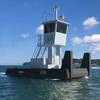The TT Club is urging container terminal operators to fit electronic sensor devices to quay crane booms to prevent them accidentally colliding with vessels during loading and unloading operations in port.
The TT Club says that crane booms colliding with the structure or equipment of a ship is an all-to-common occurrence at almost every port around the world, causing serious injuries to workers and costly repairs and operational downtime.
In advising its Members and the industry at large, TT Club highlights the frequency of such collisions, and recommends installing effective boom anti-collision systems.
Among the various types of device currently in use, the simplest consists of wires run along the length of the crane boom, which activate a switch to stop the crane if they are hit. However, this system may not stop the crane fully before a collision occurs, and, while better than nothing, does not provide the level of protection afforded by electronic sensing devices.
Among commonly used electronic sensors are a laser based unit supplied by Sick Sensor Intelligence and a radar based unit from Navtech Electronic Ltd. These sensors allow programming to provide separate warning, slow down, and stop signals to help prevent collisions. Sensor units need to be kept clean, so require access, and a solid mounting system to ensure vibration does not cause operational errors. Laser units can be affected by the sun shining on the laser sensor – but this is a problem that can easily be resolved by consulting the manufacturer Sick. The radar sensor is expensive relative to other units and can suffer from dead zones created by the trolley when using only one sensor.
Featured videos

Tracking Foreign Vessels Working in the U.S. Jones Act Market

Inmarsat Enhances Service to Drive Digitalization

Inside the Electrified Truckable Tug
Subscribe for
Maritime Reporter E-News
Maritime Reporter E-News is the maritime industry's largest circulation and most authoritative ENews Service, delivered to your Email five times per week








